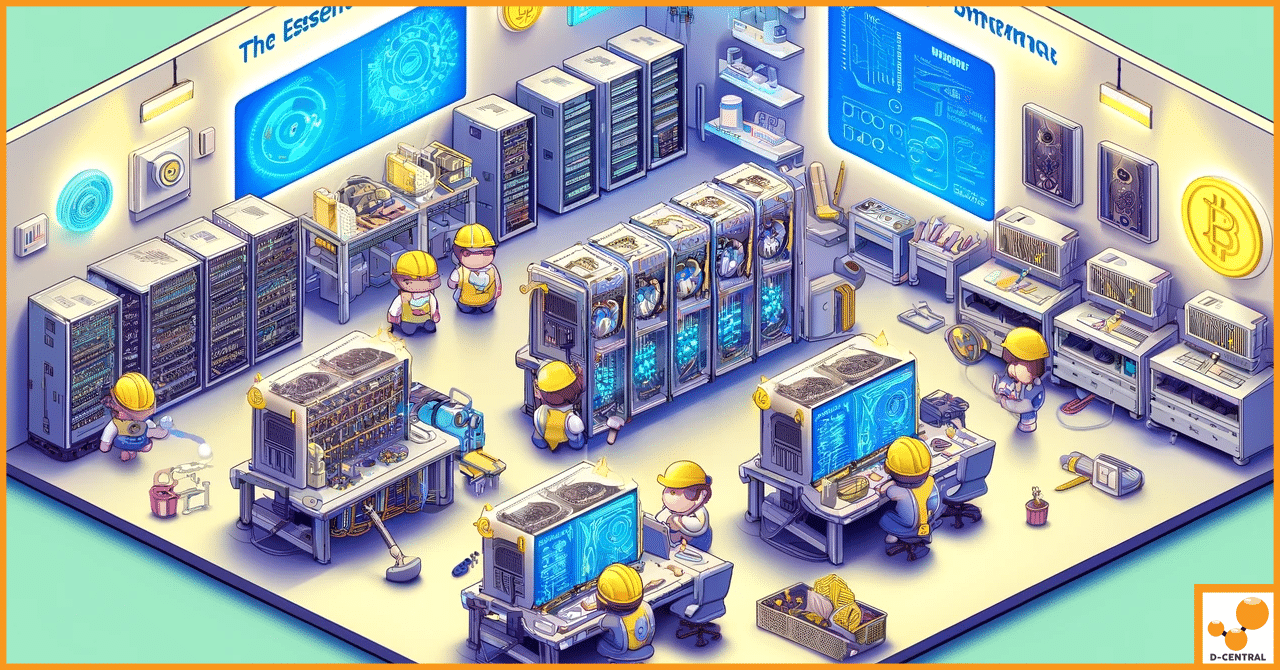
Bitcoin and Nuclear Power: A Controversial but Potentially Sustainable Solution
Bitcoin has become the most popular cryptocurrency in the world, but like many modern solutions to our problems, it comes
4479 Desserte Nord Autoroute 440, Laval, QC H7P 6E2

In the rapidly evolving world of blockchain technology, cryptocurrency mining remains a cornerstone, contributing significantly to the global ledger that enables cryptocurrencies like Bitcoin to operate securely and efficiently. This process involves the validation of transactions and the addition of these to the public ledger, known as the blockchain. However, mining is not merely about running software on powerful computers. It demands high electrical power and generates an immense amount of heat, requiring sophisticated equipment and specialized facilities to maintain optimal performance and longevity of the hardware.
Maintenance facilities are crucial in this ecosystem. They ensure that mining equipment operates at peak efficiency, which involves routine diagnostics, repairs, upgrades, and the prevention of potential failures. Without high-quality maintenance, the probability of costly downtimes increases significantly, which can jeopardize the mining operations.
Enter D-Central Technologies, a trailblazer in the Bitcoin mining landscape of Canada. Recognized as the largest ASIC repair center in the country, D-Central specializes in the comprehensive support and maintenance of mining hardware. From diagnostics to custom hardware modifications, D-Central provides a full spectrum of services designed to enhance the operational capabilities of cryptocurrency miners. By prioritizing robust maintenance protocols and advanced technological adaptations, D-Central not only extends the life of mining equipment but also boosts its efficiency, making it a pivotal player in the mining industry.
As we delve deeper into the essential elements that constitute an effective maintenance facility, it becomes clear why D-Central Technologies stands out. Their commitment to quality, coupled with their extensive expertise and innovative approaches, showcases their role in advancing the cryptocurrency mining sector. This article will explore these elements, providing insights into creating and managing a top-tier miner maintenance facility that aligns with the high demands of this dynamic market.
In the realm of cryptocurrency mining, the efficacy of the maintenance process is critically dependent on the quality and specificity of the tools used. Advanced diagnostic and repair equipment play a pivotal role in ensuring the high reliability required in this high-stakes industry.
The layout of a maintenance facility can significantly impact its efficiency. A well-thought-out design minimizes wasted movement and speeds up the repair process, crucial for reducing downtime in mining operations.
This section highlights how crucial advanced equipment and thoughtful design are to the maintenance of cryptocurrency mining facilities. By investing in high-quality diagnostic and repair tools and optimizing facility layouts, D-Central Technologies ensures that it remains at the forefront of the mining industry, providing reliable and swift services that keep mining operations around the clock.
Maintaining an optimal environment within cryptocurrency mining facilities is crucial to prevent hardware degradation and ensure operational efficiency.
The presence of dust in a mining facility can be a significant risk factor, potentially leading to equipment malfunction and a general decline in operational efficiency.
Effective environmental control is a foundational aspect of managing a cryptocurrency mining facility. By carefully regulating temperature and humidity and implementing robust dust management systems, facilities like D-Central Technologies not only enhance their operational efficiency but also significantly reduce the risk of costly downtimes and repairs. These measures ensure that the mining operations are sustainable and can achieve maximum productivity without the undue stress of environmental factors.
Effective power management is critical in cryptocurrency mining facilities to ensure operational continuity and efficiency. The setup not only needs to handle massive loads of power but also distribute it in a way that maximizes uptime and equipment longevity.
As the energy demand for cryptocurrency mining climbs, integrating renewable energy sources has become a strategic priority for reducing operational costs and enhancing sustainability.
These advancements in power management and the integration of renewable energy are crucial for the future of cryptocurrency mining. They not only ensure economic efficiency but also contribute to the environmental sustainability of the industry. D-Central’s commitment to innovation in this area highlights its role as a pioneer in the mining sector, ready to tackle the dual challenges of efficiency and sustainability.
In the high-stakes world of cryptocurrency mining, securing assets extends beyond physical measures to encompass comprehensive digital protections, ensuring both the physical and digital sanctity of the mining operations.
Continuous monitoring using advanced technologies is vital for operational efficiency and early detection of potential issues that could lead to equipment failure or security breaches.
Through meticulous planning and the integration of advanced security and monitoring systems, D-Central Technologies ensures that its facilities are not only secure from physical and cyber threats but also operationally optimized to handle the demands of modern cryptocurrency mining. These systems collectively support a secure, efficient, and reliable mining environment, demonstrating D-Central’s commitment to excellence in the cryptocurrency mining industry.
The efficiency and reliability of cryptocurrency mining facilities heavily depend on the skill and expertise of the personnel involved, particularly those tasked with the maintenance and repair of complex ASIC miners.
Continuous professional development is crucial in keeping pace with the evolving technology landscape, especially in industries as dynamic as cryptocurrency mining.
Through a robust framework of training and continuous professional development, D-Central Technologies ensures that its team not only meets but exceeds the industry standards in ASIC repair and maintenance. This commitment to excellence in human resources is what sets D-Central apart in the highly competitive field of cryptocurrency mining.
Throughout this exploration of the essential elements that constitute an effective cryptocurrency miner maintenance facility, we have highlighted the importance of sophisticated diagnostic and repair equipment, optimized facility layouts, robust environmental control systems, advanced power management setups, stringent security protocols, and comprehensive human resource training programs. Each component plays a crucial role in enhancing the efficiency, reliability, and longevity of mining operations, ensuring that facilities like D-Central Technologies can provide top-tier service.
Looking ahead, the future of cryptocurrency mining and maintenance is poised to become even more technologically advanced. Innovations in AI and machine learning could further optimize maintenance schedules and predictive repairs, reducing downtime and increasing productivity. The integration of renewable energy sources is set to redefine the operational cost structures and sustainability profiles of mining operations. As the industry continues to evolve, the emphasis on advanced training and development programs will grow, ensuring that technicians remain on the cutting edge of technology.
For those looking to elevate their mining operations, D-Central Technologies offers comprehensive solutions that cover every aspect of miner maintenance and optimization. Whether you are seeking to outfit a new mining facility or upgrade an existing operation, D-Central provides the expertise and state-of-the-art services necessary to achieve maximum efficiency and profitability.
We invite you to contact D-Central Technologies to discover how our services can enhance your mining projects. Explore our services and schedule a consultation today to learn more about our custom solutions tailored to meet your unique needs. Join us at the forefront of the cryptocurrency mining industry and ensure your operations are future-ready.
What is cryptocurrency mining and why is it important?
Cryptocurrency mining is the process of validating transactions and adding them to the public ledger, known as the blockchain. It’s vital for the operation and security of cryptocurrencies like Bitcoin.
Why are maintenance facilities crucial for cryptocurrency mining?
Maintenance facilities ensure mining equipment operates at peak efficiency through routine diagnostics, repairs, upgrades, and prevention of potential failures, reducing the risk of costly downtimes.
What services does D-Central Technologies provide?
D-Central Technologies specializes in the support and maintenance of mining hardware, offering diagnostics, custom hardware modifications, and a full spectrum of services to enhance operational capabilities of cryptocurrency miners.
How does the facility infrastructure impact the maintenance of cryptocurrency mining hardware?
The quality of tools and the facility’s organizational layout significantly impact the efficiency of maintenance processes. Specialized tools and an efficient layout optimize repair times and enhance the functionality of mining operations.
What role do environmental control systems play in mining facilities?
Environmental control systems, including temperature and humidity control, along with dust and filtration systems, are crucial for preventing hardware degradation and ensuring operational efficiency.
Why is effective power management critical in mining facilities?
Effective power management ensures operational continuity and efficiency, handling large power loads, preventing outages, and integrating renewable energy sources for sustainability.
What security measures are essential for cryptocurrency mining facilities?
Physical security measures and cybersecurity protocols are vital for protecting high-value mining equipment and maintaining the integrity of the mined cryptocurrency against theft, vandalism, and cyber attacks.
How does D-Central Technologies ensure the quality of their staff?
D-Central invests in ongoing education, training programs, and certifications such as IPC certification for their technicians, ensuring high-quality performance and adherence to global standards in ASIC repair and maintenance.
What future innovations could impact cryptocurrency miner maintenance?
Future innovations like AI and machine learning could optimize maintenance schedules and repairs, while the integration of renewable energy sources could redefine operational costs and sustainability.
How can someone benefit from D-Central Technologies’ services?
Individuals or companies looking to elevate their mining operations can contact D-Central Technologies for comprehensive solutions covering maintenance, optimization, and advanced technologies essential for maximum efficiency and profitability.
DISCLAIMER: D-Central Technologies and its associated content, including this blog, do not serve as financial advisors or official investment advisors. The insights and opinions shared here or by any guests featured in our content are provided purely for informational and educational purposes. Such communications should not be interpreted as financial, investment, legal, tax, or any form of specific advice. We are committed to advancing the knowledge and understanding of Bitcoin and its potential impact on society. However, we urge our community to proceed with caution and informed judgment in all related endeavors.
Related Posts

Bitcoin has become the most popular cryptocurrency in the world, but like many modern solutions to our problems, it comes

In the dynamic world of cryptocurrency mining, Application-Specific Integrated Circuit (ASIC) miners have emerged as specialized and powerful tools. These

Lean Six Sigma (LSS) is a synthesis of two powerful methodologies—Lean manufacturing, which focuses on eliminating waste, and Six Sigma,